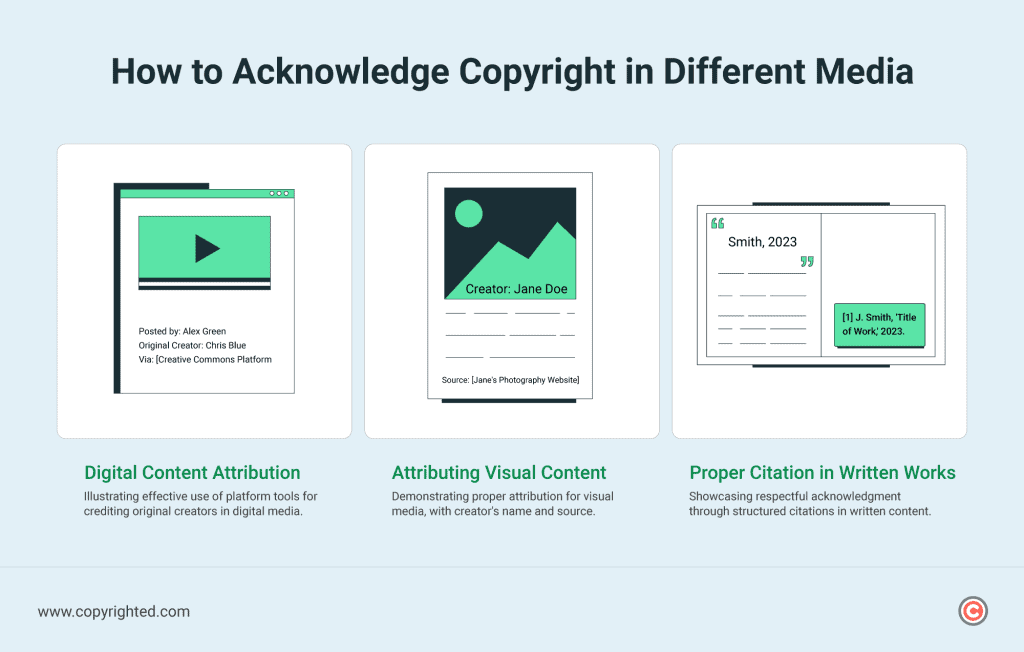Dabbling in copyright without caution can lead to serious consequences.
Consider a situation where your business includes a copyrighted song in a promotional video without permission. In this scenario, a judge could order the removal of all videos featuring the song, and you might be asked to create future promotional content without it.
The copyright owner also holds the right to seek damages and recover court costs, highlighting the financial and legal risks associated with copyright infringement.
To steer clear of such complications, it’s safer to get permission and provide copyright acknowledgment to protect your reputation, business, and creative projects.
This guide focuses on copyright acknowledgment, its importance, legal implications, and how you can do it right.
- Copyright acknowledgment is about recognizing and giving credit to creators for their work.
- Basic attribution requires the author’s name, work title, and publication date for written works and mentioning the creator’s name and source for visual content.
- By not acknowledging copyright can lead to fines and legal actions for copyright infringement.
Table of Contents
What is Copyright Acknowledgement?
Copyright acknowledgement is the respectful recognition of the intellectual property rights held by the creators of various works. It goes beyond a mere formality and is a way to honor the hard work and creativity of others while ensuring that you remain on the right side of the law.
Copyright acknowledgement recognizes the time and effort spent on the creative process of a copyrighted work, from brainstorming to editing. By acknowledging copyright, you extend your appreciation not only to the tangible product but also to the relentless passion and commitment of those who breathe life into ideas.
Beyond being a mark of gratitude, copyright acknowledgement also acts as protection that helps you stay out of legal trouble. If you don’t acknowledge copyright, you could face accusations of plagiarism or copyright infringement, leading to serious legal issues.
Copyright acknowledgement is like a friendly connection between creators and users. It creates a fair and respectful environment for creativity, where everyone’s contributions are recognized, valued, and protected.
What are Its Ethical and Legal Implications?
From an ethical standpoint, failing to get permission and give proper credit when using someone else’s copyrighted work amounts to more than just a breach of rules – it’s a matter of integrity. Imagine someone else claiming credit for your hard work, it’s an uncomfortable scenario that no creator would appreciate.
Similarly, using someone else’s work without acknowledgment is essentially claiming ownership of their creativity. This not only goes against the principles of fairness but can also harm your reputation, both as an individual and within the broader creative community.
Consider the collaborative nature of creative industries, where ideas are built upon and shared. Acknowledging copyright becomes a cornerstone of maintaining trust and positive relationships among creators.
For those working in audio or video, learning how to sample without copyright infringement is also an ethical step, allowing you to remix and reimagine without misusing someone else’s intellectual property.
When credit is given where it’s due, it creates an atmosphere of mutual respect and appreciation for each other’s contributions. Knowing what is copyright attribution, which is the practice of correctly crediting the original creator, plays a vital role in this process and ensures transparency in creative collaborations.
Now, shifting our focus to the legal domain, copyright infringement is not a matter to be taken lightly. It involves unauthorized use of someone else’s intellectual property and is a violation of The Copyright Act that can result in severe legal consequences.
Legal actions, fines, and damages are potential outcomes of copyright infringement, all of which can have a big impact on your financial well-being and professional standing.
To protect yourself legally and maintain a good ethical reputation, make sure to acknowledge someone’s copyright in your creative work.
How Do You Acknowledge Copyright in Different Media?

Now, let’s get practical. Here’s a breakdown of how to acknowledge copyright in various types of media.
For Written Works
When incorporating written content, such as articles, blog posts, or textual material, the process of acknowledgment involves multiple components to ensure a comprehensive and respectful approach.
- Name of the Copyright Holder: Include the full name of the author. If the work has multiple authors, consider listing all contributors or the primary contributor based on the nature of the content.
- Title of the Work: Clearly state the title of the work being used. Pay attention to accuracy, ensuring that the title is presented exactly as it appears in the original source.
- Publication Date: Always include the publication date of the work, if it doesn’t have a specific publication date, provide the date of access. This is particularly important for timely content or when citing materials from periodicals.
- Citation Format: Implement a standardized citation format such as APA, MLA, or Chicago, depending on the conventions relevant to your field or project. This ensures consistency and facilitates easy verification for those interested in accessing the original work.
- Placement of Acknowledgment: Choose a suitable location for the acknowledgment within your document. While footnotes are a traditional method, you may also opt for in-text mentions, ensuring clarity within the flow of your content.
- Additional Context: Offer brief contextual information about the copyright holder or the work to enhance the reader’s understanding. This can include the author’s credentials, the significance of the copyrighted material, or any relevant background information.
For Images and Visual Content
Visual content adds life to your projects, but it’s important to respect the rights of visual artists and photographers when using their work. Here’s a breakdown of how you can do that:
- Licensing Terms: Different images may have varying usage restrictions, so understanding their associated licensing terms is important. Check for specific requirements related to attribution, commercial use, and modifications.
- Attribution Details: If the image’s license requires attribution, provide a detailed acknowledgment featuring the creator’s name. Additionally, make sure you include the source of the image, which may be the creator’s website, a stock photo platform, or any other designated platform.
- Location of Attribution: Integrate the attribution seamlessly into your project. For image captions, ensure that the acknowledgment is clear and easily identifiable.
- Attribution Format: Pay attention to the format of your attribution. Depending on the context, you may choose to include the acknowledgment within the image caption, adjacent to the image, or in a credits section at the end of your project.
- Additional Information: Provide additional information about the image, if relevant. This may include details about the photographer’s portfolio, a brief description of the image’s context, or any other pertinent information that enriches the viewer’s experience and appreciation for the visual content.
- License Link: If possible, include a direct link to the license or source of the image. This not only serves as a transparent reference for users but also facilitates easy verification of the image’s usage permissions.
For Digital and Online Content
In the digital realm, the rules are similar but may vary depending on the platform. Whether you’re sharing content on social media, a website, or any online platform, be sure to follow the platform-specific guidelines for attribution.
Here are some key concepts you need to consider:
- Researching Platform-Specific Guidelines: Social media, websites, and various online platforms may have distinct rules regarding attribution. Familiarize yourself with these guidelines to ensure accurate and platform-compliant acknowledgments.
- Understanding Attribution Formats: Different digital platforms may have specific formats for attribution. Some platforms might encourage mentions in the caption, while others prefer credits in a designated section.
- Utilizing Platform Tools: Some platforms offer dedicated tools or features for crediting original creators. Explore these options, as they can streamline the acknowledgment process and ensure visibility for both the content and its creator.
- Educating Your Audience: Occasionally, your audience may not be aware of the importance of copyright acknowledgment. Take the opportunity to educate them by explaining why it matters and how they can support ethical content usage.
- Staying Updated: Digital platforms may update their policies and guidelines periodically. Stay informed about any changes and adapt your acknowledgment practices accordingly.
Frequently Asked Questions
Why is copyright acknowledgment important?
Copyright acknowledgment is key to respecting creators’ rights, avoiding legal issues, and helping promote a culture of ethical content usage.
What details should be included when acknowledging written works?
Include the author’s name, work title, and publication date for a comprehensive acknowledgment of written content.
How do you acknowledge visual content properly?
Scrutinize licensing terms, provide attribution if required, and integrate acknowledgments seamlessly into your project, considering the creator’s name and source.
Can fair use exempt you from acknowledgment requirements?
Fair use may provide exemptions, but it’s essential to understand its limitations and seek legal advice if unsure.
Why is platform-specific acknowledgment necessary for digital content?
Different platforms have unique guidelines for attribution, and adhering to them ensures compliance with copyright regulations on each platform.
How can you maintain consistency in acknowledgment practices across platforms?
Familiarize yourself with acknowledgment formats on each platform and adapt your practices accordingly to ensure consistency.


